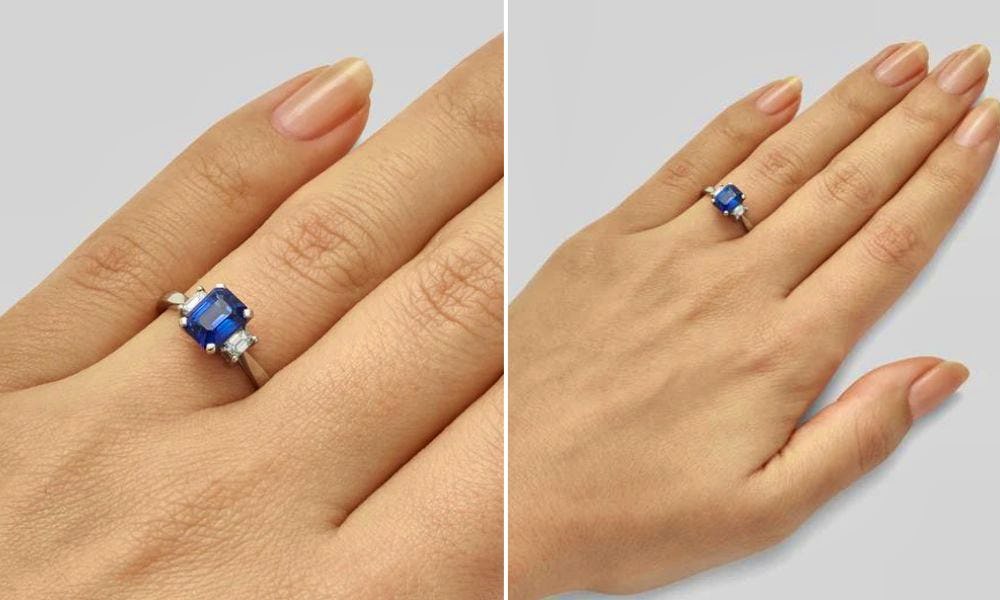During his extraordinary 66-year reign, Egyptian Pharaoh Ramesses II was famous for his battlefield exploits, his expansion of the Egyptian kingdom and his reproductive prowess, having fathered nearly 100 children with a host of wives and concubines.
But for the first half of that reign, it was one woman who captured his heart. Nefertari, who he dubbed “the one for whom the sun shines,” lived alongside her husband as his “great royal wife.”

Curator Lisa Rotondo-McCord, right, talks about the New Orleans Museum of Art exhibit “Queen Nefertari’s Egypt” that opens on Friday, March 18 during a preview tour in New Orleans, La. Thursday, March 17, 2022. (Photo by Max Becherer, NOLA.com, The Times-Picayune | The New Orleans Advocate)
When she died, about 1250 B.C., she was buried in a spectacular 6,000-square-foot tomb in an area known as the Valley of the Queens.
That tomb, the woman buried in it and the world in which she lived are the subject of a new exhibit opening up Friday at the New Orleans Museum of Art. “Queen Nefertari’s Egypt” consists of 230 items that are part of a traveling exhibition organized by the Museo Egizio, one of the world’s foremost Egyptological museums.
The tour began in Canada before the pandemic and has made several stops since then. New Orleans is its last stop before the pieces are sent back to Egypt.
Memories of King Tut
Nefertari may not be as well known as other royals such as Tutankhamun or Nefertiti, but museum officials are hoping the queen will spark the imaginations of museum goers like those featured in previous exhibits, especially King Tut, which drew huge crowds that packed the museum.
“Through the presentation of this exhibition, we hope to ignite the same sense of wonder that was sparked with NOMA’s 1977 exhibition Treasures of Tutankhamun, which visitors still reminisce about to this day,” said NOMA Director Susan Taylor.
The exhibit presents a fresh look at Egypt between 1500 B.C. and 1000 B.C. by focusing on the elite women who lived and ruled in that era. None were more elite than Nefertari. She was the principal wife to Ramesses II, regarded as perhaps Egypt’s greatest pharaoh and the one most often associated with the Exodus.

Curator Lisa Rotondo-McCord, right, talks about the New Orleans Museum of Art’s exhibit, “Queen Nefertari’s Egypt” that opens on Friday, March 18, during a preview tour in New Orleans, La. Thursday, March 17, 2022. (Photo by Max Becherer, NOLA.com, The Times-Picayune | The New Orleans Advocate)
An entire room is devoted to objects associated with the lives of the privileged women of the time, such as jars for perfume and oils, cosmetic spoons, small musical instruments and statues.
“These are the kinds of goods that would have been part and parcel of every day life for these elite women,” NOMA Curator Lisa Rotondo-McCord said. “We have indications of the kind of activities and entertainments and adornments that these women would enjoy.”
Valley of the Queens
Most of the artifacts in the show come from the south of Egypt, near the city of Thebes, around 300 miles from the famous pyramids of Giza. In the area around Thebes, the New Kingdom pharaohs — a group that includes Akhenaten, Tutankhamun and Ramesses — built massive temple complexes and dug ornate graves in areas now known as the Valley of the Kings and the Valley of the Queens.
When Italian archaeologist Ernesto Schiaparelli rediscovered Nefertari’s tomb in 1904, he found that it had been looted over the centuries. Of the actual burial, only the lid of her sarcophagus remained, and Nefertari’s mummy was nowhere to be found. But the tomb was still full of incredible pieces, including a host of shabtis, the small statuettes intended to serve the queen on her journey to the afterlife, a delicate pair of sandals, and other objects.

The New Orleans Museum of Art exhibit “Queen Nefertari’s Egypt” opens on Friday, March 18 and will feature this granite statue of Ramesses II showing the pharoah seated between the gods Amon and Mut as seen during a preview tour in New Orleans, La. Thursday, March 17, 2022. (Photo by Max Becherer, NOLA.com, The Times-Picayune | The New Orleans Advocate)
One gallery in the show also recreates portions of the vivid wall paintings that decorated the tomb, showing Nefertari appearing before the gods and making her journey to the afterlife. The sarcophagus lid, carved from pink granite, is also presented in a similar fashion to what it would have been inside the tomb.
Ancient Egypt’s artists
It’s not just the lives of kings and queens that are of interest. A separate gallery contains artifacts from the ancient village of Deir el-Medina, a royally-planned and supported village where Egypt’s top craftsmen lived and worked. The artifacts, including wooden mallets, copper chisels, a written work journal and other artifacts give a rare look into the what life was like for people outside the palace.
“This remains the single most important site for understanding the daily lives of non-royal ancient Egyptians,” Rotondo-McCord said. “It was a closed community created so that these individuals who were responsible for carving out the tombs and decorating the tombs would keep the secret of the location of those tombs” in order to thwart tomb robbers, she added.

A recreation of Queen Nefertari’s Tumb is viewed by visitors on a preview of the New Orleans Museum of Art’s exhibit “Queen Nefertari’s Egypt” that opens on Friday, March 18 in New Orleans, La. Thursday, March 17, 2022. (Photo by Max Becherer, NOLA.com, The Times-Picayune | The New Orleans Advocate)
Along one wall, the Turin Judicial Papyrus recounts in hieratic script — a cursive script used by many scribes — the punishments meted out for the coup attempt mentioned above. Dating to about 100 years after Nefertari, the papyrus itself is an impressive physical object, several feet long and with large, legible script.
A tour of the show concludes with several large painted coffins from the period immediately after the New Kingdom. Intricately painted and finely crafted, they bring to life the ancient Egyptians who once resided within.
“Queen Nefertari’s Egypt” runs through July 18 at NOMA. During the run of the show, NOMA will be open Sunday through Friday from 10 a.m.-6 p.m., Saturday 10 a.m.-5 p.m., with extended hours on Tuesdays from 10 a.m.-9 p.m. Adult admission is $25, with senior, student and military discounts. Members admitted free. Louisiana residents are admitted free to the museum on Wednesdays, but will pay $10 to see the “Queen Nefertari’s Egypt” exhibition. For information on timed entry and special ticket prices for this exhibit, visit the NOMA website.




More Stories
How To Select a Violin School
Where Can You Find the Best Music Program For Maintaining Teenagers’ Interest in Music?
Intoxicating Punjabi Tunes Achieves Prominence in Indian Music Sector